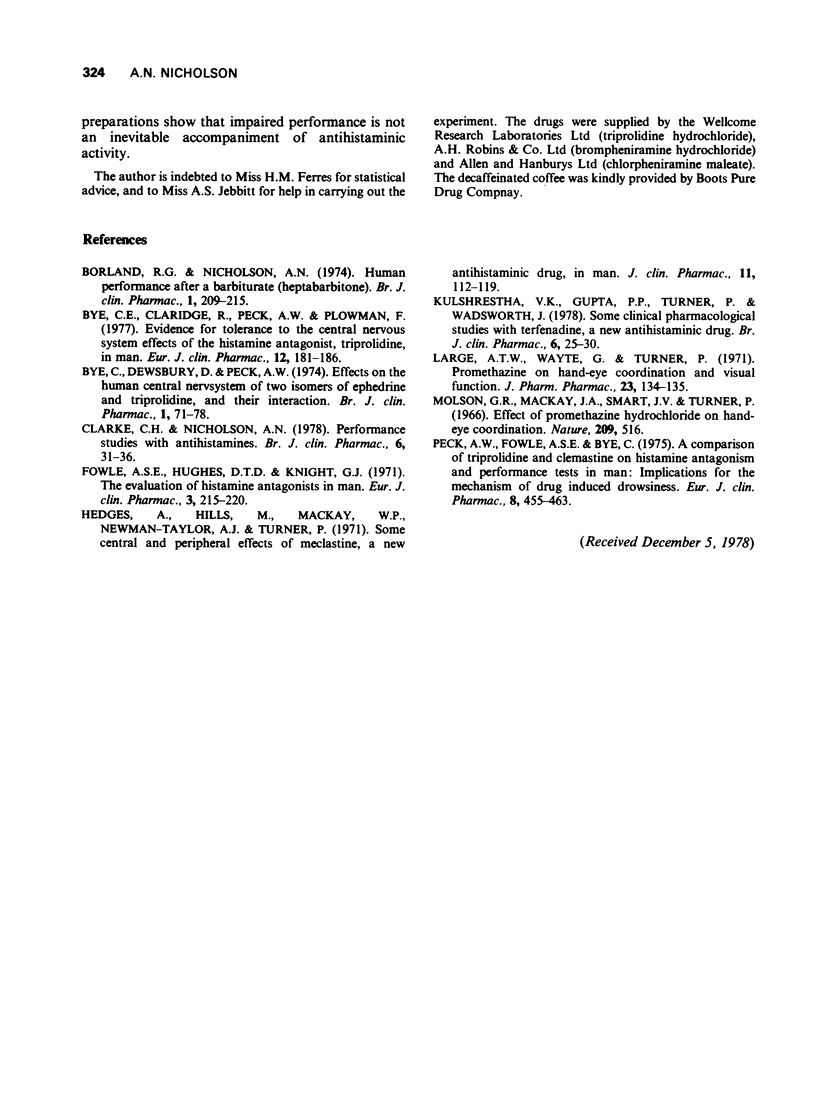Abstract
1 Effects of brompheniramine maleate (4 and 12 mg) and triprolidine hydrochloride (2.5 and 10 mg) on visuo-motor coordination, and on subjective assessments of performance, well-being and sleep were each studied in six subjects at 0.5, 1.5, 3.0, 5.0 and 7.0 h after ingestion. The doses refer to immediate and sustained release preparations respectively. 2. Triprolidine hydrochloride (2.5 mg) had an immediate effect on performance which persisted to 3.0 h, and the sustained release preparation (10 mg) impaired performance from 1.5 to 5.0 h. Brompheniramine maleate (4 mg) impaired performance from 1.5 to 3.0 h, and the sustained release preparation (12 mg) impaired performance at 1.5 h. There were no consistent changes in the subjective assessments of performance, or of well-being and sleep. 3. The studies emphasize the variable effects of antihistamines on performance, and suggest that effects on performance of sustained release preparations may be similar to those of the usual form. Sustained release preparations may provide an advantage in clinical practice if the antihistaminic activity is prolonged.
Full text
PDF



Selected References
These references are in PubMed. This may not be the complete list of references from this article.
- Bye C. E., Claridge R., Peck A. W., Plowman F. Evidence for tolerance to the central nervous effects of the histamine antagonist, triprolidine, in man. Eur J Clin Pharmacol. 1977 Nov 14;12(3):181–186. doi: 10.1007/BF00609857. [DOI] [PubMed] [Google Scholar]
- Clarke C. H., Nicholson A. N. Performance studies with antihistamines. Br J Clin Pharmacol. 1978 Jul;6(1):31–35. doi: 10.1111/j.1365-2125.1978.tb01678.x. [DOI] [PMC free article] [PubMed] [Google Scholar]
- Fowle A. S., Hughes D. T., Knight G. J. The evaluation of histamine antagonists in man. Eur J Clin Pharmacol. 1971 Sep;3(4):215–220. doi: 10.1007/BF00565009. [DOI] [PubMed] [Google Scholar]
- Hedges A., Maclay W. P., Newman-Taylor A. J., Turner P. Some central and peripheral effects of meclastine, a new antihistaminic drug, in man. J Clin Pharmacol New Drugs. 1971 Mar-Apr;11(2):112–119. doi: 10.1177/009127007101100206. [DOI] [PubMed] [Google Scholar]
- Kulshrestha V. K., Gupta P. P., Turner P., Wadsworth J. Some clinical pharmacological studies with terfenadine, a new antihistamine drug. Br J Clin Pharmacol. 1978 Jul;6(1):25–29. doi: 10.1111/j.1365-2125.1978.tb01677.x. [DOI] [PMC free article] [PubMed] [Google Scholar]
- Large A. T., Wayte G., Turner P. Promethazine on hand-eye co-ordination and visual function. J Pharm Pharmacol. 1971 Feb;23(2):134–135. doi: 10.1111/j.2042-7158.1971.tb08627.x. [DOI] [PubMed] [Google Scholar]
- Molson G. R., Mackey J. A., Smart J. V., Turner P. Effect of promethazine hydrochloride on hand-eye co-ordination. Nature. 1966 Jan 29;209(5022):516–516. doi: 10.1038/209516a0. [DOI] [PubMed] [Google Scholar]
- Peck A. W., Fowle A. S., Bye C. A comparison of triprolidine and clemastine on histamine antagonism and performance tests in man: implications for the mechanism of drug induced drowsiness. Eur J Clin Pharmacol. 1975 Aug 14;8(6):455–463. doi: 10.1007/BF00562321. [DOI] [PubMed] [Google Scholar]


